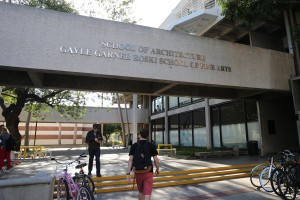School links theory with practice
ArchDaily recently commended the School of Architecture’s program for bridging the gap between theory and practice.
ArchDaily’s report was based on rankings by DesignIntelligence, which released rankings of architecture schools in the United States in November. In DesignIntelligence’s rankings, the School of Architecture undergraduate program placed seventh in the country.

Landmark victory · Students walk outside the School of Architecture. The school placed seventh in DesignIntelligence’s yearly rankings. – Ralf Cheung | Daily Trojan
This ranking was a significant advancement for the school, which was ranked 16th last year and had not broken the top ten in the past eight years.
DesignIntelligence, the chief source of rankings for architecture and design schools, also ranked schools in specific categories, including Cross-Disciplinary Teamwork, Communication, Design, Research and Theory, Construction Methods and Materials, and Sustainable Design Practices and Principles. Of these six categories, USC placed in the top five for five of the categories.
ArchDaily grouped the categories into two groups: design and theory, and practical construction and sustainability. USC was the only school to have placed in the top five of categories in both groups.
“The University of Southern California seems to be producing uniquely balanced architects … this university may be one to watch in the future,” the ArchDaily article said.
In order to rank these schools, Greenway Group surveyed an array of individuals related to architectural academics. Six hundred and ninety-three professional practices and corporations were surveyed, an almost 250 percent increase from the 282 firms that responded in 2013. To add depth to the results, 89 deans and chairs of architecture schools were asked what they thought were weighing issues facing architectural instructors today and 2,760 architecture students were asked about their satisfaction with their architectural schooling.
Joseph Cohan, a fourth-year architecture student, agreed that DesignIntelligence’s rankings reflect the diversity of the USC architecture program.
“I’m pretty grateful that we learn about sustainability and cost,” Cohan said. “We learn about each of the parts of design as opposed to schools like Berkeley, which is heavily sustainable, or Harvard, which doesn’t take cost or sustainability into account.”
Bryan Sandoval, a junior majoring in business administration and architecture, was most impressed with the School of Architecture’s use of technology and integrating it into architectural practices.
“Many schools stick with traditional methods and drawing, but at USC, it’s about being able to translate anything from paper onto a computer,” Sandoval said.
The USC School of Architecture features many interdisciplinary programs. One of these majors is civil engineering with an emphasis in building science, a program that involves both the Viterbi School of Engineering and the School of Architecture. This major “involves all stages of designing a building, from formulating the original conceptualization to creating drawings for construction,” according to the Viterbi website.
Noah Cherner, a sophomore in the building science program, said he is grateful for the opportunity to prepare early for the realities of the architecture world, but more importantly, he noted that USC has taught him to treat every design like it is a personalized gift.
“At USC, it’s not just about design or making a product that you can mass produce … at USC, they really emphasize making something sacred,” Cherner said.
Sandoval said one thing that makes the School of Architecture distinct is the unique backgrounds of the faculty and staff that contribute to their architectural tastes. He recalled that one of his professors did her undergraduate work in literature, but continued on to get her graduate degree in architecture.
“Different backgrounds make for different perspectives and professors are encouraging all different types of architecture,” Sandoval said.
Cherner credited the School of Architecture’s high ranking to the faculty at USC who encourage their students to work hard and constantly challenge themselves.
“I think [this ranking] really sheds light on the amount of work that the architecture students at USC put in … It shows that USC has amazing architecture faculty that want to push their students to the limit,” Cherner said.
